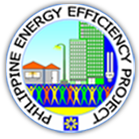
"One of the key objectives of the Philippines Energy Efficiency Project (PEEP) is the demonstration of the societal benefits of implementation of a series of energy efficiency projects in the commercial, residential and public sectors. In addition it addresses a key public health issue of residual mercury that is likely to increase through the implementation of EE projects.
The Philippines Efficient Lighting Market Transformation Project (PELMATP) implemented by the Department of Energy (DOE) since 2005, complimented by the Government Energy Management Program (GEMP) has been the cornerstone of PEEP. This is supported by the Administrative Order No: 183 (Directing the use of Energy Efficient Lighting / Lighting Systems (EELs) in Government Facilities – Palit-Ilaw Program) The order stipulates the retrofits of EELs in Government Buildings towards the reduction of 10% in energy consumption mandated by previous Administrative Orders (AOs 103, 110 and 126). The implementation of these AOs was spearheaded by the EUMB-EECD. The national government agencies including its regional bureaus and offices undergo an un-announced spot check energy audit to assess and verify compliance with the orders of the President. In addition, monthly monitoring of fuel and electricity consumption is a requirement to apprise the Office of the President on the actual reduction in energy consumption and monetary savings generated by the government sector.
PELMATP focussed on addressing the barriers to widespread use of efficient lighting through EE policies and standards, technology applications, capacity building, consumer awareness, financing initiatives and lamp waste management (LWM) policies. Hence, PEEP will enhance the activities initiated by PELMATP and implement a critical mass of projects that would establish sustainable business models for large scale implementation of EE projects in the future.
The key objectives of the project are as follows:
– Retrofitting of about 42 government Buildings with efficient lighting systems (ELS) and the establishment of a model for large-scale implementation in the public sector.
– Distribution of 13 Million CFLs amongst residential consumers nationwide and the design and adoption of a methodology under CDM for certification and trading of CERs.
– Successful demonstration of efficient street lights and traffic lighting in LGUs; and the establishment of a model for standardizing public lighting and large scale implementation.
– Expansion of the capacity of LATL to conduct efficiency testing on a wider range of appliances and the accreditation of the laboratory to ISO 17025.
– Procurement of a Lamp Waste Management facility and the establishment of a business model for collection of lamp waste and the operation of the facility.
– Successful operation of a Super ESCO including capacitated staff and energy service models for implementing EE projects in public and private sectors.
– Establishment of an efficient building rating system in the Philippines for new and retrofitted buildings."